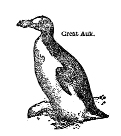The great auk, now extinct, was the Northern Hemisphere’s only flightless diving bird, a flamboyant, goose-sized, stubby-winged creature which had the dubious distinction of being called geirfugl, garfuge, gearbhul, aponar, binocle, moyack, the “penguin,” and the wobble, as well as “so very fat” and “exceeding fat” by explorers, settlers, Norsemen, and sundry plunderers of yesteryear.
One of its last habitats was the aptly named Funk Island, off the coast of Newfoundland. As great auks could not fly, they were easily surrounded by fishermen and driven into stone pounds, where they were systematically killed. These poor geirfugl were immersed in large kettles of boiling water, and their feathers were plucked.
According to contemporary sources, their bodies were tossed like logs onto the fires, turning into fuel to heat the water. Wobble feathers were sold and stuffed into pillows and quilts. Wobble eggs were salted and sold for a few pence a dozen.
Possibly the last remaining great auk was picked up dead in Trinity Bay, Newfoundland, in 1853.
Dr. Nina Karnovsky, ornithologist and veteran of the guinea-pig-show circuit, has spent many months in the Arctic studying the little auk or dovekie, a tender smaller bird that can fly, most of the time. (Little auks are known to overindulge in great feasts of zooplankton and then struggle to get airborne, an easy target for passing ships.)
I asked Dr. K., “Why study the little auk?” “These birds eat from the ocean,” she said. “They tell us what’s happening with the ocean and the climate.” With global warming, waters around Spitsbergen, a major breeding site for dovekie colonies, are warming up, and their meal of choice, the big Arctic zooplankton, is giving way to a smaller species of plankton. Because they’re so sensitive to changes in their environment—in the ice, the water temperature, the weather—they’re an ideal species to observe.
And then there’s the cute factor. The black-and-white little auk is a charmer with its short, stubby bill, comical flying habits, and almost spherical shape. Despite the fact that these ice birds are pocket-sized, they show no fear of people, displaying what Dr. K. refers to as “island naïveté.” “In certain remote places there are no land predators. A penguin will think you’re a penguin. Little auks will come sit right next to you. You get smelly when you work with auks. When you study what they’re eating, they will puke all over you.”
Little auks migrate off the west coast of Greenland to Nova Scotia and the Gulf of Maine, or from the west coast of Spitsbergen to the southwest coast of Greenland. Sometimes they’re blown off course by violent storms and show up in places as unlikely as a “house spouting” on the Brighton seafront. A passel of lost auks is known as a “wreck.”The English have kept a touching log of auk wrecks dating back to 1948, citing location of said lost birds as well as their condition. 1990 was an annus terribilis for the little auk. One was “picked up exhausted” at Pagham Beach on the third of November, six west off Hastings on November 4, eight west off Worthing, a whopping thirteen west at Selsey Bill on the twenty-ninth of December. The log continues, citing dead birds, exhausted birds, dying birds. The grand total of wrecked auks for 1990 comes to eighty-four, what seems to be an auk wreck record.
The chubby little auk is the treat of choice for Greenlanders, who send their kids out with long-handled nets to catch them. They stuff the birds into a seal’s stomach and then bury the stomach for a year. The Little auks turn into the consistency of cottage cheese. The Greenlanders eat this spongiform delicacy—known as kiviak—with great gusto, spitting out the feathers. Children request kiviak for their birthday in lieu of cake.





